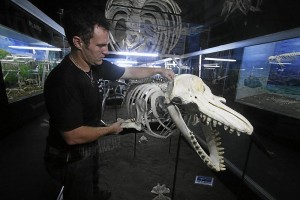In Davao, bones offer green lessons

DARRELL Blatchley, son of American missionaries in the Philippines, in his D’Bone Collector Museum in Davao City KARLOS MANLUPIG
DAVAO CITY—His is no ordinary collection: over 200 skeletons of animals, including that of a rare 41-foot sperm whale.
This is why Darrell Blatchley, 32, an American from Idaho who has settled in Davao City, is eager to explain in Cebuano what are on display at the newly opened D’Bone Collector Museum in the city’s Barangay Bucana.
“This is an educational center where we can learn about the life and death of animals. The motivation behind this museum is to teach the people, particularly the locals, to take extra care of our environment, most especially our marine life,” Blatchley said.
On the ground floor of the three-story building are preserved remains, skulls and bones of bears, a lion, horses, deer, monkeys, snakes, crocodiles, birds, a dugong, dolphins, whales and insects, among other animals.
Cause of death
Most of the skeletal remains of dolphins and whales were given names related to the causes of death.
“Alcoholic,” a False Killer Whale, was found with a bottle of an alcoholic drink in the stomach. Plastic garbage was found in the stomach of “Lost,” a Blainville’s Beaked Whale, which might have caused its death and the loss of its baby.
Aside from pollution, Blatchley identified shark bites, parasitic infection and getting snagged in nets as causes of deaths of the dolphins and whales on display.
Blatchley is proud of his rare possession of two sperm whale bones, including a 41-foot skeleton at the center of the museum. These are among the 47 displayed across the globe and two of only four in the Philippines, he notes.
Childhood dream
A son of American missionaries, Blatchley transferred to the Philippines when he was 15 years old. He married a Filipino and has two children.
The museum is a realization of his childhood dream to collect wildlife bones for public display to raise awareness of environmental destruction and spur people’s action.
His curiosity with animals and skeletal remains started when he received a set of antlers of a mule from an uncle.
“My interest was reinforced when we transferred to Thailand when I was 5. The people in the community where we served were very eager in preserving the skulls and bones of animals,” Blatchley said.
“What is more amazing is that the people there has a particular story to tell with every piece of bone they have in their possession,” he said.
Aside from preserving dead specimens, the museum and its facility are engaged in conserving and rescuing marine animals in danger.
“We respond immediately to any report we receive from the local fisherfolk and authorities when there are beached or snagged dolphins or whales. We are also trained to apply first aid and rehabilitation to these lovely creatures and, later on, return them to the sea,” Blatchley said.
Funding woe
He laments that funds are not enough to cover the center’s operational costs. The museum charges only P50 for an adult and P40 for a child as entrance fees.
“I am still buried in debt to my parents. We need this to be the best in the Philippines, that is why we are also hoping that different government agencies will also support our efforts,” Blatchley said.
He said he had tried to work with government agencies in the retrieval and preservation of the remains of aquatic animals.
“We are begging the Department of Environment and Natural Resources to donate to us the confiscated and recovered animal remains, most especially the rare ones, instead of their usual procedure of burning or burying them,” he said.
Blatchley also called on people to donate animal skeletons in their possession to the museum.
“However, I warn the public not to kill animals just to display it. These bones in my collection were not acquired through illegal means,” he said.














